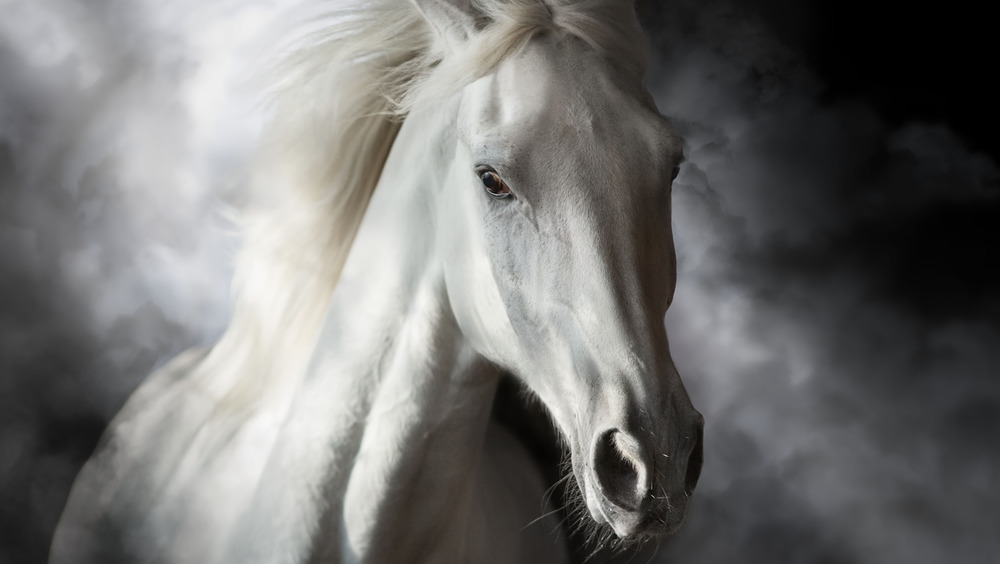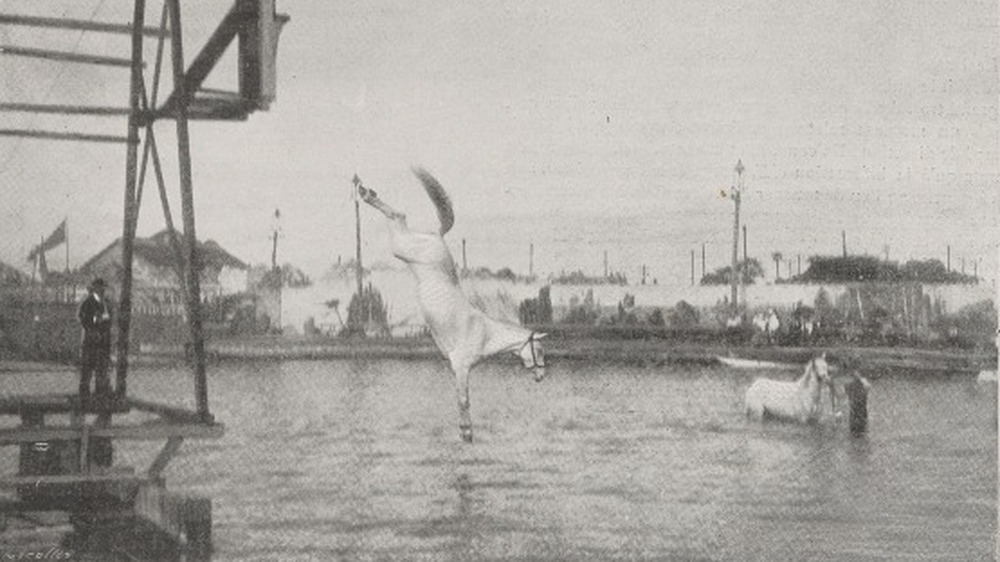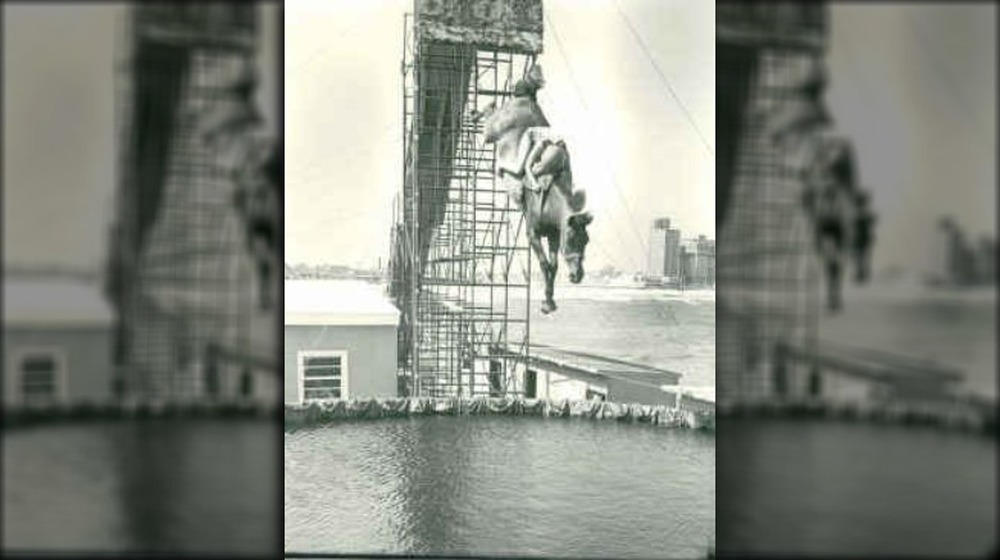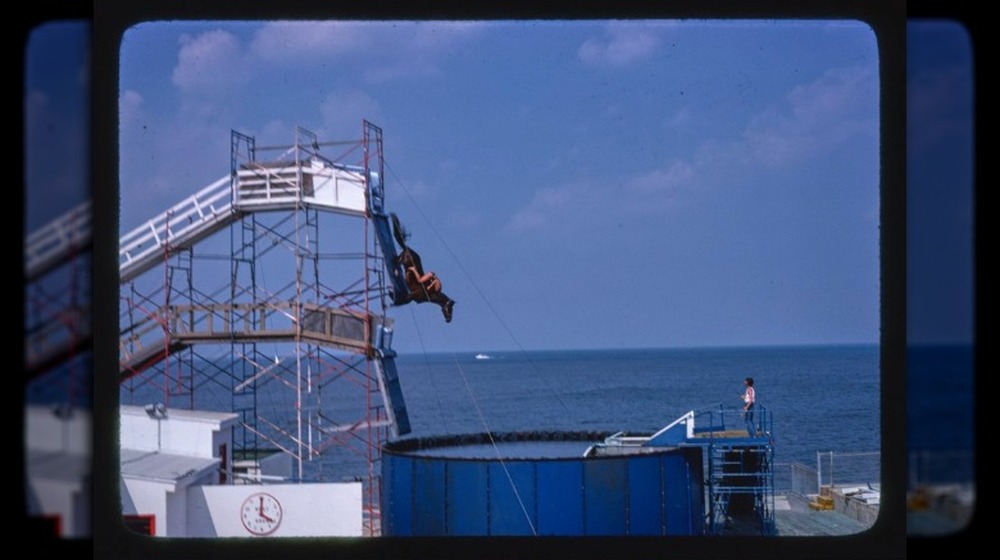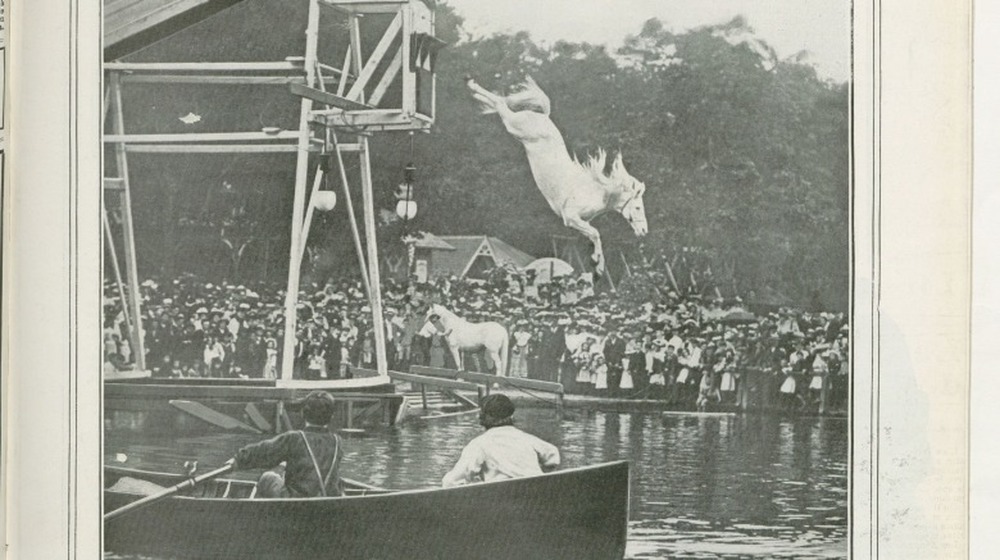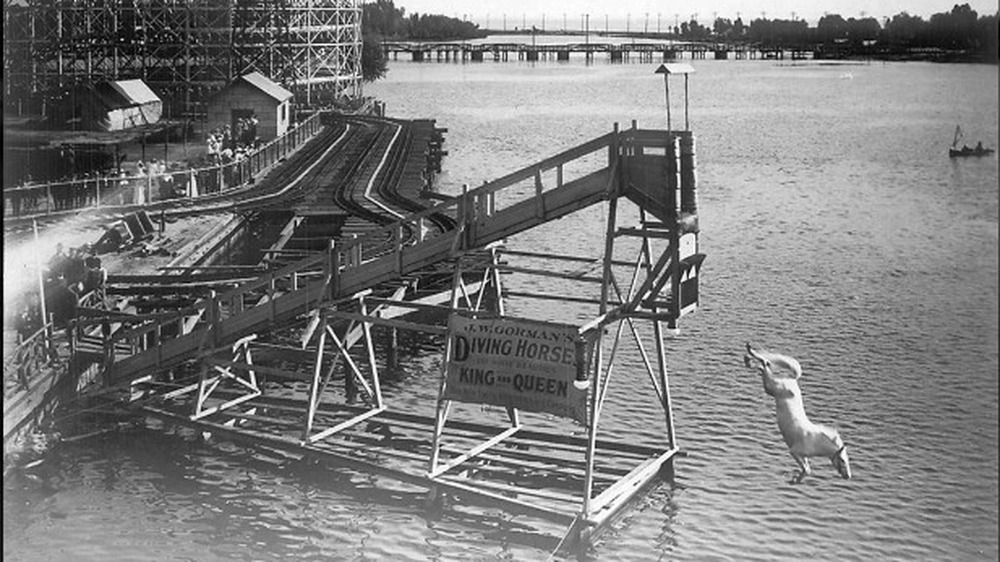The Messed Up Truth About The History Of Diving Horses
From a certain 21st century perspective, people in the 19th century were weird. Back then, they didn't have TV, so they had to think of other — often outrageous or outright stupid — ways to entertain themselves. One such fad was the utterly harebrained exhibition of horse diving, which was exactly what it sounds like. People paid good money to watch someone push a horse off a platform as high as 60 feet to plunge into a pool of water only 10 feet deep. And that was it. That was the show.
Shows featuring diving horses began in the 1880s and were a wildly popular attraction for decades, despite the obvious cruelty to the animals and the danger it posed, ironically, it would seem, more for the riders than the horses themselves. It took a while, but animal rights activists were fortunately able to finally bring the practice to an end by the 1970s. Still, there were those who tried to revive this extremely dumb idea, possibly inspired by a Disney movie in 1991 that somehow presented people who pushed horses into swimming pools as heroes. Let's take a look at messed up truth about diving horses and how it thankfully came to an end.
A broken bridge led to a bad idea
According to Texas Escapes, horse diving was "invented" by a man named William "Doc" Carver. Carver had worked with Buffalo Bill Cody, but by the 1880s he was traveling the country with his own Wild West show. He was a champion sharpshooter, and his rifle skills were the main attraction to the show, but after a while he added a new gimmick: diving horses.
How Doc Carver even got the idea to jump horses into ponds may be up for debate, but he said he was inspired by a daring personal experience. He said that while riding over a bridge that began to collapse, he was forced to jump his horse off of it into the river below. And thus, the horse diving show was born. As The New York Times reports, horse diving shows became very popular in Texas, where they were a regular act at carnivals and state fairs. Carver had his daughter Loreena jump the horses into the water, despite a terrible accident that proved the practice was unsafe.
A diving horse tragedy in San Antonio, Texas
In 1907, "The Great Carver Show" set up shop in San Antonio's Electric Park. San Antonio was the biggest city in Texas at the time, and people came from all over to hand their 50 cents over to Carver and watch the horse diving show. But tragedy struck on February 17 when 18-year-old Oscar Smith was killed in an unfortunate horse dive. (The good news is, the horse survived.)
Texas Escapes writer Mike Cox excoriated the San Antonio papers that reported the fatal event, as they were obviously more concerned with bragging about their photography skills than reporting Smith's death. "It is not often that a newspaper is enabled to print an actual photograph of a man within three seconds of accidental death and while in the act leading to it," wrote the Light, which published the photo above. But the paper knew what the people wanted to see and ended up printing another run of the story for those who wanted their own copy of the picture. It also published an ad for Carver's show two days after Smith's death, with no mention of the horse diver's untimely demise.
Diving horses take up residency in Atlantic City
Carver took his show on the road, and in 1924 he hired a young woman named Sonora Webster to jump horses. She ended up marrying William's son Al. William Carver died in 1927, after which Al took the show off the road and installed it in Atlantic City, New Jersey. It was a permanent attraction on the city's popular Steel Pier amusement park. The horse diving show ran anywhere from two to six times a day, seven days a week.
According to Women of Age Riding Horses, the show featured a 40-foot wooden ramp, from which the horse and rider plunged into a pool of water 11 feet deep. The girls who rode the horses as they dove had to watch out, as the horses would throw their heads back for balance as they fell. Many diving girls suffered broken noses, black eyes, fractured collarbones, and other injuries. Sonora herself suffered a unique injury that would go on to be the stuff of Disney movie magic.
Sonora Webster suffered a terrible accident on a diving horse
Amusing Planet recounts the terrible horse diving accident that left Sonora Webster completely blind one day in 1931. She had been jumping horses for nearly a decade, but that day, she somehow didn't close her eyes in time before she and her equine pal "Red Lips" hit the water, and the impact caused her retinas to become detached. After that, Sonora was completely blind.
But she didn't let a pesky case of permanent blindness stop her from diving horses. Sonora continued to do the weird activity for another 11 years. She even wrote an autobiography about it, the 1961 book A Girl and Five Brave Horses. In what was perhaps an even weirder decision than jumping horses into swimming pools, Disney turned her story into the 1991 film Wild Hearts Can't Be Broken, framing Sonora as some kind of hero for — again — jumping horses into swimming pools. The Los Angeles Times wrote that she "made history when she plummeted 40 feet on horseback into a tank of water," revealing the paper's fairly low bar for what it takes to make history.
Animal rights activists put an end to diving horses
Opposition from animal welfare activists brought the horse diving shows in Atlantic City to an end in the 1970s. Then in 1993 — most likely trying to cash in on the popularity of the Disney movie — the Steel Pier amusement park tried to bring them back. This time, however, they pushed poor, helpless and riderless mules off the platform, not horses. Animal rights activists were, once again, not happy about this, and the revival was short-lived after vociferous protests.
The amusement park considered bringing back the show again in 2012, but animal rights activists didn't even let them take one equestrian dive. Official reports always stated that, although the riders got the snot beat out of them when diving horses, the animals were miraculously never harmed at all. PETA, obviously, did not agree. It claimed that there were several unreported injuries to diving horses, such as damage to the internal organs, broken bones, bruises, and injuries to the legs and spines. The Humane Society of the United States also spoke out against the idea. After the park's owner announced he was scrapping plans to dive horses again, the president of the Humane Society told Reuters, "This is a merciful end to a colossally stupid idea."
